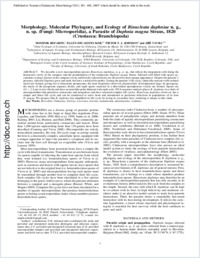Morphology, molecular phylogeny, and ecology of Binucleata daphniae n. g., n. sp. (Fungi: Microsporidia), a parasite of Daphnia magna Straus, 1820 (Crustacea: Branchiopoda)
- Refardt, Dominik Unité Ecologie et Evolution, Université de Fribourg, Switzerland
- Decaestecker, Ellen Laboratory of Aquatic Ecology and Evolutionary Biology, Leuven, Belgium - Laboratory of Aquatic Biology, Interdisciplinary Research Center,Kortrijk, Belgium
- Johnson, Pieter T. J. Department of Ecology and Evolutionary Biology, Ramaley, University of Colorado, Boulder, Colorado, USA
- Vávra, Jirí Biological Centre of the Czech Academy of Sciences, Institute of Parasitology, České Budějovice, Czech Republic - Faculty of Biology, University of South Bohemia, České Budějovice, Czech Republic
-
19.04.2008
Published in:
- Journal of Eukaryotic Microbiology. - 2008, vol. 55, no. 5, p. 393 - 408
English
We describe a new microsporidian species Binucleata daphniae, n. g., n. sp., that infects the integument cells lining the hemocoele cavity of the carapace and the postabdomen of the cladoceran Daphnia magna Straus. Infected cells filled with spores accumulate as large clusters in the carapace cavity and heavily infected hosts are detected by their opaque appearance. Despite the parasite's presence, infected Daphnia grow and molt, but have a reduced fecundity. During the parasite's life cycle, chain-like meronts with isolated nuclei are formed, giving rise to binucleate presporonts, the most frequently observed, characteristic developmental stage. In sporogony, the nuclei of the presporont separate, divide, and eight spores enclosed in a thin-walled sporophorous vesicle are formed. Spores are 4.9 × 2.5 μm in size (fresh) and have an anisofilar polar filament with eight coils. DNA sequence analysis places B. daphniae in a clade of microsporidians that parasitize crustaceans and mosquitoes and have assumed complex life cycles. Binucleata daphniae, however, has a simple and direct life cycle and can be transferred to naïve hosts and maintained as persistent infections in populations of its host D. magna. We propose that B. daphniae has simplified its life cycle by losing its secondary host, rendering it unique in this clade.
- Faculty
- Faculté des sciences et de médecine
- Department
- Département de Biologie
- Language
-
- English
- Classification
- Biological sciences
- License
-
License undefined
- Identifiers
-
- RERO DOC 10815
- DOI 10.1111/j.1550-7408.2008.00341.x
- Persistent URL
- https://folia.unifr.ch/unifr/documents/300971
Statistics
Document views: 135
File downloads:
- pdf: 303
